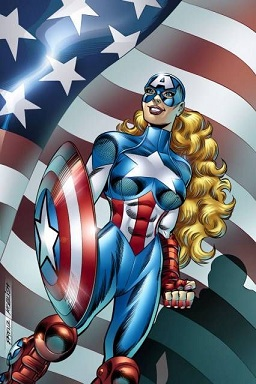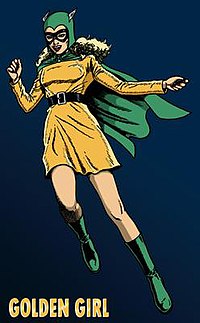
Captain America is a superhero created by Joe Simon and Jack Kirby who appears in American comic books published by Marvel Comics. The character first appeared in Captain America Comics #1, published on December 20, 1940, by Timely Comics, a corporate predecessor to Marvel. Captain America's civilian identity is Steven "Steve" Rogers, a frail man enhanced to the peak of human physical perfection by an experimental "super-soldier serum" after joining the United States Army to aid the country's efforts in World War II. Equipped with an American flag–inspired costume and a virtually indestructible shield, Captain America and his sidekick Bucky Barnes clashed frequently with the villainous Red Skull and other members of the Axis powers. In the final days of the war, an accident left Captain America frozen in a state of suspended animation until he was revived in modern times. He resumes his exploits as a costumed hero and becomes leader of the superhero team the Avengers, but frequently struggles as a "man out of time" to adjust to the new era.

The Red Skull is the alias of several supervillains appearing in American comic books published by Marvel Comics. Created by France Herron, Jack Kirby, and Joe Simon, the character first appeared in Captain America Comics #1, in which his secret identity is revealed to be George Maxon. It would later be retroactively established that Maxon was merely a decoy who was working for the real Red Skull, Johann Shmidt. Other individuals, including Albert Malik and Shmidt's own daughter Sinthea, have also adopted the Red Skull persona.

Rick Jones is a character appearing in American comic books published by Marvel Comics. The character has been depicted as a sidekick and friend to the Hulk, Captain America, Mar-Vell / Captain Marvel, Rom the Spaceknight, and Genis-Vell / Captain Marvel.

Elizabeth "Betty" Ross is a character appearing in American comic books published by Marvel Comics. Created by Stan Lee and Jack Kirby, the character first appeared in The Incredible Hulk #1 (1962) as a romantic interest of the Hulk. She is the daughter of General Thaddeus E. "Thunderbolt" Ross. Over the years, the character has undergone multiple transformations, including the Harpy and Red She-Hulk.

The Invaders is the name of two fictional superhero teams appearing in American comic books published by Marvel Comics.

Miss America is a superhero appearing in American comic books published by Marvel Comics. Created by writer Otto Binder and artist Al Gabriele, the character first appeared in Marvel Mystery Comics #49 in the Golden Age of Comic Books. Madeline Joyce is the first incarnation of Miss America. The character has also been a member of the Invaders, Liberty Legion, and All-Winners Squad at various points in her history.

The Falcon is a superhero appearing in American comic books published by Marvel Comics. The character was introduced by writer-editor Stan Lee and artist Gene Colan in Captain America #117
Bucky is the name used by several different fictional characters appearing in American comic books published by Marvel Comics, usually as a sidekick to Captain America. The original version was created by Joe Simon and Jack Kirby and first appeared in Captain America Comics #1, which was published by Marvel's predecessor, Timely Comics. Following the apparent death of the hero James "Bucky" Barnes, the Bucky nickname and costume have been used by various heroes including: Fred Davis, Jack Monroe, Rick Jones, Lemar Hoskins, and Rikki Barnes. For a time, a child looked after by Jack Monroe was named "Bucky," but she was later adopted and given the name Julia Winters.

Patriot is the name of several superheroes appearing in American comic books published by Marvel Comics. The first incarnation of Patriot, Jeffrey Mace, first appeared in Human Torch Comics #4. The second incarnation, Eli Bradley, debuted in Young Avengers #1. The third incarnation, Rayshaun Lucas, made his first appearance in Captain America: Sam Wilson #18.

Hawkeye is a fictional character appearing in American comic books published by Marvel Comics. Created by writer Allan Heinberg and artist Jim Cheung, Bishop first appeared in Young Avengers #1. She is the third character and first female to take the Hawkeye name, after Clint Barton of the Avengers and Wyatt McDonald of the Squadron Supreme. Her costume appearance is patterned on the first Hawkeye and Mockingbird.

The All-Winners Squad is a fictional superhero team appearing in American comic books published by Marvel Comics. The company's first such team, it first appeared in All Winners Comics #19, published by Marvel predecessor Timely Comics during the period fans and historians call the Golden Age of Comic Books.

Jeffrey Solomon Mace, also known as the Patriot and Captain America, is a superhero appearing in American comic books published by Marvel Comics. The character was created during the 1940s, a period fans and historians call the Golden Age of Comic Books. As the Patriot, he first appeared in Human Torch Comics #4, published by Marvel's 1940s precursor, Timely Comics.

The Blonde Phantom is a fictional masked crime fighter appearing in American comic books published by Marvel Comics. Created for Marvel predecessor Timely Comics by Stan Lee and Syd Shores, the character first appeared in All Select Comics #11, during the 1940s period fans and historians call the Golden Age of Comic Books. The heroine was so well received that the next issue was retitled The Blonde Phantom. The series continued to feature her until issue #22. She also appeared in backup stories in many other Timely comics; in Superhero Comics of the Golden Age, Mike Benton observes that "for a few months in 1948, readers could find her in seven titles on the newsstand." In The Supergirls, Mike Madrid asserted, "Once again, a capable woman hid behind a meek persona and only let her hair down, literally, to come to the aid of a man who completely ignored her unless she assumed a disguise. In a 1947 story entitled "I Hate Myself", Louise even dreams that Mark finally confesses his love for her, only to have the Blonde Phantom persona appear and steal him away."

Battlestar is a superhero appearing in American comic books published by Marvel Comics. Created by Mark Gruenwald and Paul Neary, the character made his first appearance in Captain America #323 (1986). He became the fifth character to assume the alias Bucky before taking on the name "Battlestar."

American Dream is a superhero appearing in American comic books published by Marvel Comics. Created by writer Tom DeFalco and artist Brent Anderson, the character first appeared in A-Next#1. Shannon Carter comes from an alternative future timeline of the Marvel Universe known as the MC2 Universe. She wears a costume similar to that of the comic book superhero Steve Rogers / Captain America. Her weapons are throwing disks and the trademark shield.

William Burnside, PhD, also known as the Captain America of the 1950s, Commie Smasher or Bad Cap, is a fictional character appearing in American comic books published by Marvel Comics. He was created by writer Steve Englehart and artist Sal Buscema in Captain America #153–156 as an explanation for the reappearance of Captain America and Bucky in 1953 in Young Men comics and their subsequent adventures in the 1950s. It established through retroactive continuity that the character was a completely different one from the original Captain America, who was firmly established in The Avengers #4 as disappearing near the end of World War II. Since this revelation, the character serves as a foil personality to his predecessor, serving as an example of what Captain America would have become and as a reactionary bigot driven violently insane by a flawed and incomplete copy of Project Rebirth's body enhancement treatment.

The Whizzer is a superhero appearing in American comic books published by Marvel Comics. He first appeared during the period called the Golden Age of Comic Books.

James Buchanan "Bucky" Barnes is a character appearing in American comic books published by Marvel Comics. Originally introduced as a sidekick to Captain America, the character was created by Joe Simon and Jack Kirby and first appeared in Captain America Comics #1. Barnes' original costume and the Bucky nickname have been used by other heroes in the Marvel Universe over the years.

Jack Monroe is a fictional superhero appearing in American comic books published by Marvel Comics. The character was originally introduced as the third sidekick under the Bucky identity, initially treated as the original Bucky Barnes before being retconned as a separate character, and later the most well-known incarnation of Nomad.

















